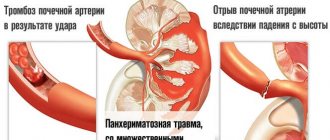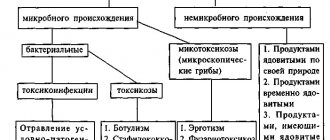HEMOTHORAX
(
haemothorax
; Greek haima blood + thorax chest; syn.
hematothorax
) - accumulation of blood in the pleural cavity.
G.'s description as a complication of chest wounds is already found among doctors of the Middle Ages - Paracelsus, A. Pare. The first scientifically based recommendations for the treatment of G. belong to N. I. Pirogov. Until the end of the 19th century. There was a tactic for treating G. with late (3-5 days after injury) punctures. In 1916, at the XIV Congress of Russian Surgeons, many surgeons (in particular, L. G. Stukkey) advocated active tactics for open chest wounds, including those with G. However, early pleural punctures for G. began to be used only in during the fighting on the river. Khalkhin-Gol (M. N. Akhutpin, A. A. Vishnevsky). Modern principles of treatment of G. were developed during the Great Patriotic War by V.-I. Kolesov, P. A. Kupriyanov, V. S. Levit and others.
Classification
Depending on the amount of blood poured into the pleural cavity, small, medium, and large (total) blood are distinguished. With small blood, the blood often occupies only the sinuses of the pleural cavity; with medium blood, it reaches the angle of the scapula; with large (total) G.—occupies the entire or almost the entire pleural cavity.
In addition, limited G. is isolated (usually small), in which the spilled blood due to pleural adhesions or rapid coagulation accumulates in certain areas of the pleural cavity; Depending on the location, apical, interlobar, subphrenic, paracostal, and diastinal in pairs are distinguished.
There are G. with stopped or ongoing bleeding. Depending on the presence or absence of infection in the pleural cavity, they speak of infected (pyohemothorax) or uninfected G. When blood that has spilled into the pleural cavity coagulates, G. is called coagulated. G. can be closed or open; with the simultaneous presence of air and blood in the pleural cavity, we are talking about hemopneumothorax.
Etiology and pathogenesis
The most common cause of G. is lung damage. According to V.I. Kolesov (1949), the frequency of G. during the Great Patriotic War with penetrating chest wounds varied between 55-80%. In peacetime, according to E. M. Wagner (1969), with closed chest injuries accompanied by lung damage, G. is observed in 25.9% of patients; it occurs more often (30.2%) in injuries with bone damage than without bone damage (12.4%). After any transpleural surgery, postoperative G. occurs, which is not a complication, but in some cases, postoperative G. can acquire independent significance. In these cases, we are talking about either intrapleural bleeding or coagulated hemorrhage. Extremely rarely, hemorrhage can be a complication of pleural punctures. In addition to trauma, G. can develop as a complication of certain diseases (pulmonary tuberculosis, neoplasms of the lungs, pleura, mediastinum or chest wall, aneurysms of large intrathoracic vessels, hemorrhagic diathesis, etc.).
G. is formed when the integrity of or increases in the permeability of the vessels of the lungs, pleura, or chest wall and mediastinum are impaired. In injuries, the blood vessels of the lungs are most often damaged. The amount of blood flowing into the pleural cavity; depends on the degree of destruction of the lung and the location of the injury. Damage to the peripheral parts of the lung is usually accompanied by minor or moderate swelling; wounds in the area of the root of the lung with damage to the great vessels are accompanied by massive and rapid bleeding (major hemorrhage) and are almost always fatal.
Already in the first hours of being in the pleural cavity, blood causes a reaction of the pleural layers - aseptic inflammation of the pleura, the so-called. hemopleurisy. At first, the composition of the blood poured into the pleural cavity is almost no different from peripheral blood, but gradually the amount of hemoglobin in it decreases, and the erythrocyte-leukocyte index decreases. Usually the blood in the pleural cavity does not coagulate, but gradually the loss of individual components occurs and thrombosis occurs and the process of fibrinolysis begins. In addition, the blood flowing from the lung contains anticoagulant substances, which also prevents blood clotting. In cases where the bleeding is very severe, blood clotting may occur (the more blood is poured into the pleural cavity per unit of time, the more clots are formed); The blood retains its ability to clot only for 4-5 hours after bleeding has stopped.
Patol, changes in the pleura in G. are characterized by swelling and moderate leukocyte infiltration, mainly of its connective tissue layers; there is also swelling, discomplexation and desquamation of mesothelial cells. At a later date (after the third day), infiltration by polyblasts and proliferation of fibroblasts appear.
Compression of the lung, especially pronounced in moderate and severe hemorrhage, as well as in hemopneumothorax, is accompanied by a decrease in the respiratory surface of the lung and aggravates respiratory and circulatory disorders. Displacement of the mediastinum with compression of the vena cava and pulmonary vessels, in turn, has an adverse effect on hemodynamics. This is especially pronounced in open hemopneumothorax, accompanied by mediastinal flotation and pleuropulmonary shock.
Causes
The causes of the disease can be divided into 3 groups:
- Traumatic. Intrapleural bleeding occurs against the background of open or closed chest injury. Traumatic hemothorax is common and can develop in cases of:
- car accident;
- impacts on the ground or water;
- gunshot and stab wounds to the chest;
- blunt bruised wounds;
- rib fractures.
- Pathological. This group includes various diseases. Pathology occurs against the background of such diseases:
- tuberculosis;
- lung abscess;
- oncological processes;
- hemorrhagic diathesis;
- artery aneurysm;
- coagulopathy.
- Iatrogenic. It is a consequence of various surgical interventions.
The pathological process can be spontaneous in nature. The causes of hemorrhage remain unknown.
Clinical picture
The clinical picture depends on the severity of bleeding, compression and damage to the lung and mediastinal displacement.
The condition of the wounded and patients with large G. is severe. There is anxiety, shortness of breath, chest pain, cough, sometimes with hemoptysis, less often pulmonary hemorrhage, pallor and cyanosis of the skin, increased heart rate, and decreased blood pressure. The patient's position is often semi-sitting.
With average G., the condition of the wounded and sick is less severe, but pallor, tachycardia, shortness of breath, and even slight physical symptoms are noted. the load causes them to increase these symptoms.
The condition of the wounded and patients with minor G. can be relatively satisfactory. Pain, an occasional cough and moderate shortness of breath may disappear on their own within a few days.
On examination, a lag in the affected half of the chest during breathing is noted. Voice tremors are weakened, there is dullness of percussion sound, displacement of the mediastinum, limited mobility of the lower pulmonary edge, the degree of which depends on the amount of blood in the pleural cavity. Sometimes Birmer's symptom is detected - a change in sound during percussion of the chest depending on the position of the patient's body due to the free movement of spilled blood in the pleural cavity; in a sitting position the sound is lower than in a lying position.
G.'s infection leads to a deterioration in the patient's general condition. Apathy, lethargy, tachycardia, increased body temperature and other signs of pleural empyema appear (see Pleurisy, purulent).
The diagnosis is based on anamnesis, clinical roentgenol, research and the results of pleural punctures. The amount of blood loss is judged by various tests used in wedge practice (see Blood loss).
Aspiration of blood from the pleural cavity during puncture is a reliable diagnostic sign of G. Certain diagnostic difficulties arise with coagulated G., when pleural puncture manages to obtain only a small amount of dark blood. Sterile and infected G. can be differentiated by the nature of the punctate, using a simple and fairly reliable test by N. N. Petrov. The blood obtained during puncture is diluted with dist and water 5 times - in the absence of infection after hemolysis, the liquid remains clear, but in the presence of infection it becomes cloudy. Bacteriol and cytol have a certain diagnostic value. punctate examination. You can judge the cessation of bleeding into the pleural cavity using the Ruvilois-Gregoire test: if the blood obtained during pleural puncture coagulates in a syringe or test tube, the bleeding continues; if the blood does not clot, the bleeding has stopped or continues extremely slowly.
For X-ray diagnostics of G., polypositional examination is used (see). In an upright position of the patient, a small amount of blood can accumulate in the supradiaphragmatic space, creating the erroneous idea that the dome of the diaphragm is high and its mobility is limited. Giving the patient a horizontal position causes either the spreading of blood along the posterior surface of the lung, which will manifest itself as a uniform decrease in the transparency of the corresponding pulmonary field, or the flow of fluid into the paramediastinal space and a symptom of expansion of the mediastinal shadow. The accumulation of small amounts of blood only in the posterior pleural sinus can be detected by lateroscopy.
If G. reaches 200-300 ml, a decrease in the transparency of the triangular-shaped pulmonary field appears, merging with the diaphragm and the characteristic oblique upper border. The accumulation of a large amount of blood is accompanied by a shift of the mediastinum to the opposite side. The appearance of air in the pleural cavity during hemopneumothorax (hemopneumothorax) is determined by the presence of a horizontal level of liquid and air above it.
Treatment
Small sterile G. can resolve on its own without any treatment. events. G.'s resorption occurs slowly, within 1-2 months. As the blood in the pleural cavity is absorbed, it is gradually “diluted” with exudate and the contents of the pleural cavity become serous. In most patients, after G.'s elimination, pleural adhesions remain.
In most cases, treatment of small and medium-sized G. without signs of ongoing bleeding and associated infection is carried out by pleural puncture along with drug treatment. Pleural puncture (see) is carried out according to the generally accepted method, if possible, all blood is removed from the cavity.
Infected or coagulated G. in most cases leads to the occurrence of pleural empyema. Therefore, in all cases, blood and inflammatory exudate should be removed as much as possible from the pleural cavity immediately after the diagnosis of G. or hemopleuritis is established. Coagulated blood is an indication for thoracotomy (see), removal of blood clots and drainage of the pleural cavity.
Large hemorrhage, caused by damage to large vessels, can lead to death from acute blood loss within a few hours; therefore, in most cases with large hemorrhage and hemorrhage with ongoing bleeding, emergency thoracotomy with suturing of the lung wound or ligation of the vessel is indicated.
Depending on the indicators of the coagulation and fibrinolytic systems in patients with bleeding into the pleural cavity in the immediate postoperative period after radical interventions on the lungs, ε-aminocaproic acid, protamine sulfate, trasylol, fibrinogen, the introduction of single-group plasma and other hemostasis are used under the control of fibrinogen concentration values , blood clotting time and indicators of fibrinolytic activity (V. T. Pleshakov, 1969). If they are ineffective, rethoracotomy is indicated to stop bleeding. To compensate for blood loss, reinfusion of blood spilled into the pleural cavity is permissible, but only for injuries without significant damage to the lung tissue, when there are no signs of blood infection, and not. later than 12 hours, after the injury.
First aid
If intrapleural bleeding is suspected, the victim should be given first aid, which consists of performing the following actions:
- Call an ambulance.
- Lay the patient down so that the head is higher than the rest of the body.
- Apply a cold object to the affected area of the chest.
- In case of a closed sternum injury, a pressure bandage must be applied during the phase of maximum exhalation.
- In case of an open injury, carefully clean the wound of contamination and apply an aseptic dressing.
If possible, you can administer analgin solution intramuscularly to the victim and give cardiovascular medications.









